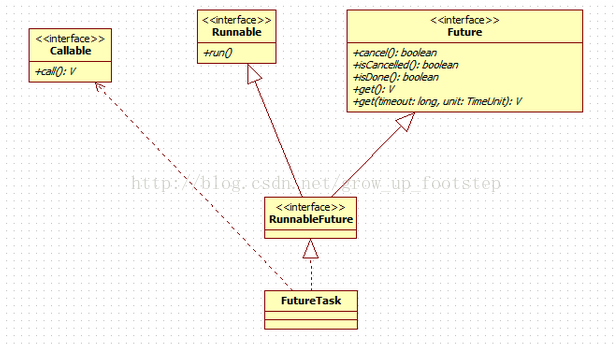public interface Runnable {
public abstract void run();
}
public class Thread implements Runnable {
private Runnable target;
public Thread() {
create(null, null, null, 0);
}
public Thread(Runnable target) {
init(null, target, "Thread-" + nextThreadNum(), 0);
}
init中this.target = target;
public synchronized void start() {
start0();}
private native void start0();
@Override
public void run() {
if (target != null) {
target.run();
}
}
}
不需要返回结果时,可以使用继承Thread类和实现Runnable接口来创建线程
以上为部分源码当继承Thread类创建线程时,覆写run方法其实还是在实现Runnable接口中的抽象方法run,new对象时调用的是Thread类中的无参构造器,调用其start方法执行
run方法体;实现Runnable接口来创建线程时,实现其抽象方法run,执行run方法只能使用Thread类中的start方法(native),所以newThread类对象时调用的是其有参构造器,将实现的Runnable接口赋值给This.Runnable,使用Thread类中的start方法执行实现Runnable接口中覆写的run方法
所以两种方法都是实现实现Runnable的抽象方法run,使用Thread类中的start方法执行其run方法体
当需要线程返回执行结果时,就要使用Callable接口
public interface Callable<V> {
/**
* Computes a result, or throws an exception if unable to do so.
*
* @return computed result
* @throws Exception if unable to compute a result
*/
V call() throws Exception;
}
与runable接口类似callable接口也只有一个方法call,返回结果使用泛型
如图java 5提供future接口来代表Callable接口里call方法的返回值,并为future接口提供了一个futureTask实现类,该实现类实现了Future接口,并实现了Runnable接口,
可以作为Thread类的Target以下为FutureTask的两个构造方法
public FutureTask(Runnable runnable, V result) {
this.callable = Executors.callable(runnable, result);
this.state = NEW; // ensure visibility of callable
}
public FutureTask(Callable<V> callable) {
if (callable == null)
throw new NullPointerException();
this.callable = callable;
this.state = NEW; // ensure visibility of callable
}
为了更好的使用线程,下面学习一下线程池方面的知识
线程池在系统启动时即创建大量空闲的线程,程序将一个runnable对象或callable对象传给线程池,线程池就启动一个线程来执行它们的run或call方法,当run或call方法执行
结束后,该线程并不会死亡,而是再次返回到线程池中成为空闲状态,等待执行下一个Runnable对象或callable对象的run或call方法
java5开始新增一个Executors工厂类来产生线程池,ExecutorService代表尽快执行线程的线程池(只要线程池有空闲线程,就立即执行线程任务)程序只要将一个Runnable对象
或callable对象提交给线程池,该线程池就会尽快执行该任务
<T> Future<T> submit(Callable<T> task);
<T> Future<T> submit(Runnable task, T result);
Future<?> submit(Runnable task);
一般情况下使用第一个和第三个
使用举例:http://www.cnblogs.com/ruiati/p/6133174.html
参考 http://www.cnblogs.com/cuimiemie/p/6445154.html
http://www.cnblogs.com/ruiati/p/6133174.html






















 741
741

 被折叠的 条评论
为什么被折叠?
被折叠的 条评论
为什么被折叠?








